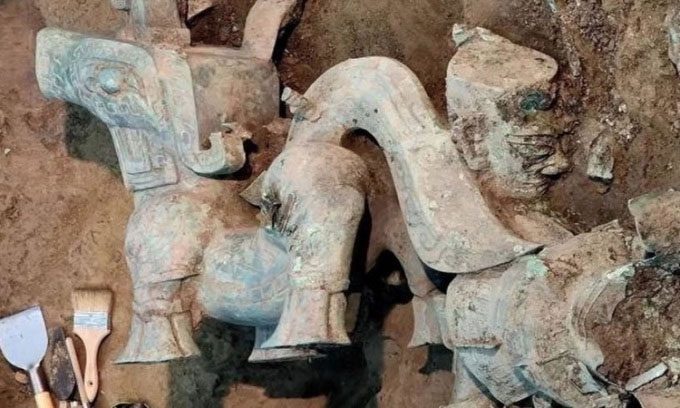Archaeologists have unearthed a large bronze monster statue, one of the most valuable treasures, at the Sanxingdui archaeological site, located in a burial pit in Sichuan Province.

Bronze monster statue weighing 150kg. (Photo: Weibo)
The bronze statue was discovered in July of last year, but the archaeological team was unable to lift it from the ground until August 24, after removing other bronze artifacts located above the statue. This bronze creature is the largest among the artifacts excavated over several decades at the site, weighing approximately 150 kg and featuring a large mouth, a slender waist, large ears, and four hooves.
According to Zhao Hao, an archaeologist from Peking University responsible for the excavation site containing the statue, all other bronze animals discovered at Sanxingdui since the excavation began in the 1980s have measured 20 to 30 cm in height. This particular creature, however, is significantly larger, with both height and width measuring around one meter.
A human figure is attached to a horn on the creature’s head, appearing to ride or control the beast. Another human-shaped artifact, missing its head, was found beside the creature. Various human figures in different poses were also discovered nearby. Zhao speculates that these figures were originally attached to the body of the bronze monster. He and his colleagues also noted the presence of a divine tree emblem cast on the creature’s chest, indicating that the people of Sanxingdui worshipped this divine tree. They suspect that a larger object was affixed to the back of the bronze monster, which has yet to be unearthed.
As one of the most significant archaeological discoveries of the 20th century, the Sanxingdui site is believed to be located in the heart of the ancient Shu kingdom, dating back approximately 4,500 years. However, researchers have yet to find records of this civilization. The site was identified in the city of Guanghan in the late 1920s, but excavation work did not commence until the 1980s. Archaeologists uncovered two burial pits containing over 1,700 artifacts, including more than 400 high-value Group A artifacts of historical and cultural significance.
The excavation process was paused in 2002 and resumed in 2020 after the archaeological team identified an additional six burial pits. Since then, they have discovered an additional 13,000 artifacts, including a bronze altar with human figures, a bronze statue of a human-headed serpent, and a bronze statue of a dragon with a pig’s nose. The latest excavation is set to be completed in September 2022, after which archaeologists will begin restoring, categorizing, and studying the artifacts.





















































